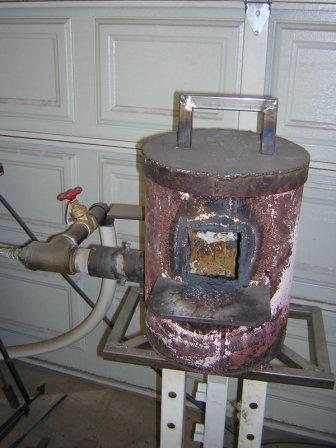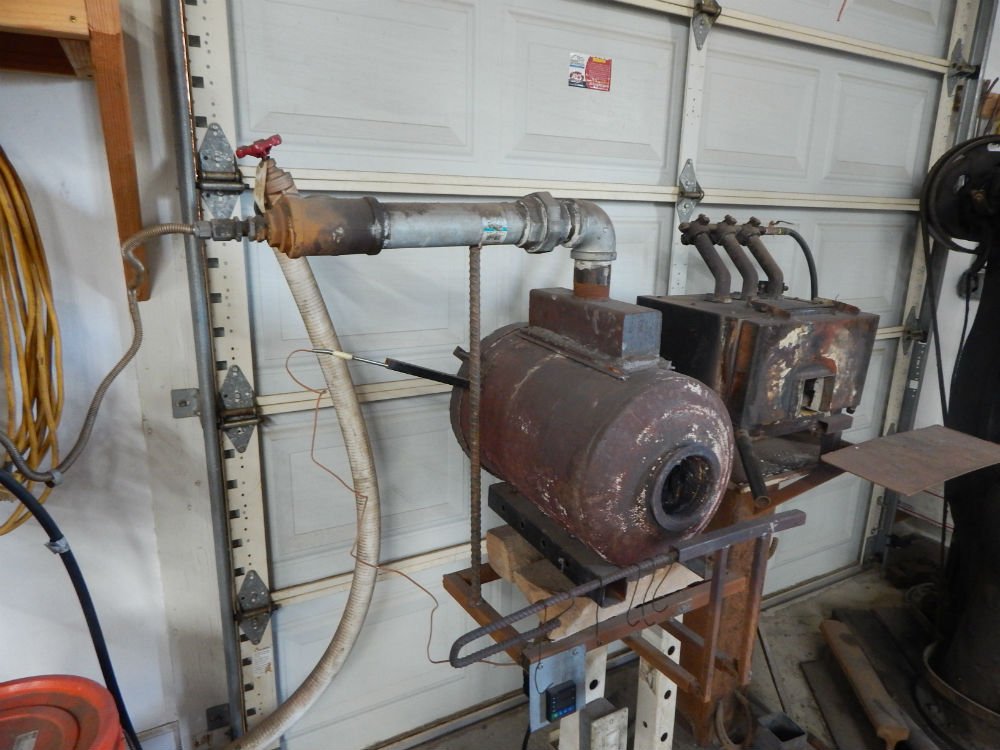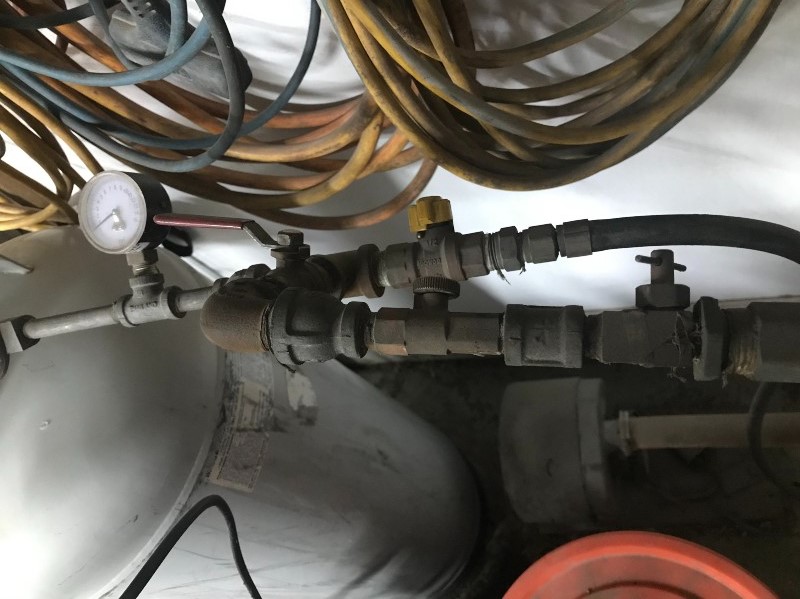Hi all,
My dad and I have been trying to make a forge for making damascus, but we can't get it hot enough. We think it is because the gas aperture is too small, at 0.035 in. but we aren't sure, and would appreciate any suggestions. The pipe size is 1 in. and the rest of the dimensions are in the photo.

Gas orifices are not required in forced air forges. You do need a needle valve for each burner branch as well as a main adjustable gas regulator. For that size forge, your air piping looks a little small and your gas piping quite large (if you are running propane, for natural gas you are fine at 1" pipe). The real key is to take a look at your flame. If it is reducing you need more air (open air valve, increase air piping diameter, or get a bigger blower), if it is oxidizing you need more gas (get rid of or drill out orifice to 1/4", increase gas pressure at variable regulator...). If it is blowing out past the end of your burner flare you have too much gas air mixture for the current temperature of the inside of you forge (turn down both gas and air till forge gets hotter). If it is burning back into the mixing tube add more air and gas.
Your forge design may also be an issue. How good is the insulation on the walls, do you have an IR reflective coating, have you cured your refractory correctly, do you use doors...
Andrew, I have built two forced air burner forges. The first one was a vertical forge with a 2 inch pipe for the burner at the bottom of a section of a water heater that was about a 14 inch diameter. The forge stood about 18 inches tall. Ed Caffrey had a wonderful thread here on a rebuild that was much more complicated than the one I built, but Ed builds stuff to last for a long time. He has since deleted that thread, but a search has turned up this one, which has a link to it on his knifemaker training blog. If you want, I can send you a diagram of the one I built. It looked like this.
I now have a ribbon burner in a horizontal forge and my setup is also from an old water heater. My chamber allows for 16 inches of stock inside the body. The ribbon burner is easy to make. Mine is 12 inches long and about 3 inches wide (IIRC) with 3 rows of 1/4 inch holes for a total of 24 holes. You could probably down size the burner slightly for your forge body. Here is a link to the directions on how to build the ribbon burner by John Emmerling. Here is my forge, and I use it for welding and general forging.
You can see the air supply is 1-1/2" diameter tube running through a gate valve at the top. The gas enters into the back side of a 2" Tee. What you cannot see is that there is a 6" long 1/4" pipe inside that Tee to get the gas downstream of the air intake.
Here are the gas controls.
On the far left is a 100# propane tank with an adjustable regulator. This is a 1/4" gas line that runs to a pressure gauge and then into a Tee fitting (this setup runs two forges). The yellow shutoff valve feeds my wife's 3-burner venturi forge. The 3/4" red shutoff feeds the forced air forge. Out of the red valve the line reduces back to 1/4" and goes into a 4-position ball valve (i will explain why in a minute). Out of that the line goes to the needle valve that Dan was referring to above. That feeds into the Tee in the first photo through a flexible gas appliance connector.
What the 4-position ball valve does is this:
I get the system tuned so that in the 2-click or halfway open position, the forge will idle at around 1950*F. This is my general forging setpoint. I can open the ball valve about halfway to the third click, add a little air with the gate valve, and I am at welding temp. If I shut the gas down to half a click below the original setpoint, and reduce the air a bit, the forge idles at 1600*F for normalizing.
Let me know if I need to clarify any of that.
I run this at 3.5# of propane pressure at the adjustable regulator.
Joshua States
www.dosgatosforge.com
https://www.youtube.com/channel/UCdJMFMqnbLYqv965xd64vYg
https://www.facebook.com/dos.gatos.71
Also on Instagram and Facebook as J.States Bladesmith
“So I'm lightin' out for the territory, ahead of the scared and the weak and the mean spirited, because Aunt Sally is fixin’ to adopt me and civilize me, and I can't stand it. I've been there before.â€
This is my blower. Keep it simple.
I have 7 PSi regulated in by black pipe from my tank outside.
Then I step down with another regulator to this blower assembly. I run 2300 degrees at 2 psi using liquid filled gauges.
I have three forges - vertical and horizontal - and all three use the same style blower, each with quick disconnect fitting, shut-off valve, needle valve and gate valve for the air.
In the last video I show my horizontal forge. I really had to learn to use that thing right. It is so well insulated that it would CRUMBLE the 2700 degree fire brick I use for the doors. I can only run that thing at about 1.6 PSI or it literally burns up my steel.


[media] http://www.youtube.c...8T8F_QHnDk&t=6s [/media]
[media] http://www.youtube.c...h?v=CEG9_BQFazU [/media]
Karl B. Andersen
Journeyman Smith
To the OP..... if you notice, most of the pics of forges that followed your initial post are all single burner (first hint). All of those forges also have the burner size and the forge size correctly/consistently "matched".
What I see in the picture you posted....
-The burners are significantly too large for the forge body you're using them in.
-Multiple burners= BAD JUJU! Here's the skinny.... The ONLY ways you will ever be able to "balance" the burners in a multi-burner forge, is to have TOTALLY independent fuel feeds to each burner. From the fuel source/tank, all the way to each individual burner. As it is setup, you simply will not/cannot avoid having one burner running rich, and another starving.... it occurs in any forge with multiple burners, it's just less noticeable on some than others.
-Your forge/burner are being starved for air. The rule of thumb for any venturi type burner is for the "bell" (where the venturi effect is created/air is sucked in) is AT LEAST 3X larger then the burner/pipe diameter..... so if you're running 1" pipe, the air intake should be AT LEAST 3" in diameter to pull in enough air.
-When it comes to building any forge.... KISS!! Your forge had FAR too many angles, curves, and fittings. Simply put, when it comes to a gas forge....the more you overtake the plumbing, the easier it is to stop up the drain. <img src=' http://www.americanbladesmith.com/ipboard/public/style_emoticons//wink.gi f' class='bbc_emoticon' alt=';)' />
-Next, are the manner in which the burners are setup/enter the forge body. The reason that most Bladesmiths recommend a round designed forge, particularly for creating Damascus, is to take advantage of indirect heating. Or, you might know it by "the swirling flame/effect". Not trying to be mean, but using a round body, and then having burners enter as shown in the photo is pretty much a waste. The idea with a round forge body, is to have the burners enter on a "tangent".... meaning a rather severe angle, so that the flame from the burner is directed to following the interior curvature of the forge. This prevents significant problems that are created when burners/flames are directed right at/on whatever steel your working on.
Ideally, this is how you want to setup burners in a round forge body..

- A SINGLE, correctly size BLOWN type burner is far simpler, easier, efficient, durable, and is just an overall better choice.

The above burner, from the fan is.... 12" long X 2" Black iron pipe, going into a 2"x 1 1/2" 90 degree elbow (necessary to create turbulence for air/fuel mixing) going into a 1 1/2" X 12" black iron pipe, which goes into the forge. The end of the 1 1/2" pipe has "concentric pipes" welded in for 3" to quiet the burner.. otherwise it sounds like a jet engine running in the shop.

Ideally you want the fuel coming in as far away from where it combusts as possible.... and at a sharp angle as pictured. Doing so causes more "tumbling" (mixing) of the air fuel mix, for better/more efficient combustion. A simple 1/4 pipe nipple, threaded into the 2" pipe, just above the burner, a propane needle valve, and they a length of propane hose/line gong to an adjustable regulator, and then to the fuel source.
I mentioned KISS earlier. As you can see from the above image, not much to it. That particular burner has powered every welding forge that I haver built/used for the past two decades (including the blower).
OH! A note about forge blowers....seek out and purchase/use a blower that is DESGINGED FOR FORGE USE! My recommendation is to look up "Blacksmiths Depot" and seek/buy a blower of at least 120 CFM. When it comes to a forge blower, it is always a best practice to have more blower than you need. Why? Because if you max out a blower, and it's not enough, then your stuck. About the only way out is to buy another blower that is larger then the one you maxed out! Where as if you have more blower than needed, you can always choke it down with the shutter, or in my case, I use a ceiling fan speed controller (NOT A LIGHT DIMMER SWITCH..which will burn out the blower) to "dial" it down.
Finally.... DO NOT USE ANY GALVANIZED ITEMS IN ANY FORGE APPLICATION!! BLACK IRON OR BARE STEEL ONLY!! Burning galvanizing puts off toxic gas! I'd rather be talking to you...than about you!!!<img src=' http://www.americanbladesmith.com/ipboard/public/style_emoticons//wink.gi f' class='bbc_emoticon' alt=';)' />
Hope that's helpful!
Ed Caffrey, ABS MS
"The Montana Bladesmith"
www.CaffreyKnives.net
Wow, thanks for all the fast replies! You have really given me a lot of useful information.
We are planning on removing the gas orifices and seeing if that makes any difference. If that doesn't work, we will have some potentially major redesigning to do. I might add that we don't have a flare to mix the air and the gas together as it enters the chamber, it is a straight tube.
We can't get needle valves where we live. Is this absolutely necessary for having the right amount of control or can a ball or gate valve work?
|quoted:
The real key is to take a look at your flame. If it is reducing you need more air (open air valve, increase air piping diameter, or get a bigger blower), if it is oxidizing you need more gas (get rid of or drill out orifice to 1/4", increase gas pressure at variable regulator...).
Can you please explain what you mean by "reducing" and "oxidizing"? Am I correct in assuming that this means that if there is forge scale on the billet, we need more gas, and if it isn't hot enough we need more air?
Thank you, Ed Caffery, for your post. It was really helpful for the design. It looks like we will be making a few modifications. I guess I know what we will be starting on tomorrow. I will let you know how it turns out when we get the parts we need. (We live in rural Africa. It's a bit difficult to get parts here.)
|quoted:
We can't get needle valves where we live. Is this absolutely necessary for having the right amount of control or can a ball or gate valve work?
Can you please explain what you mean by "reducing" and "oxidizing"? Am I correct in assuming that this means that if there is forge scale on the billet, we need more gas, and if it isn't hot enough we need more air?
Needle valves are not absolutely required, but are a cheap alternative to having two regulators, one for each gas burner connection from your main.
You do have a blower connected to your "Forced Air Forge" right? It was just removed for the picture I assumed. If you alternatively have a naturally aspirated forge (often called ventauri) without a blower you have a lot more problems, many of which Ed listed. In that case I would recommend you scrap your current burner altogether and try to follow an existing, fully worked out design exactly. The modified Riel, Frosty Tee and Zoeller Sidearm burners are all good easy to construct choices.
Unfortunately forge scale is only a loose indicator of whether your system is reducing or oxidizing. Yes your billet will scale up more in an oxidizing flame, but as a beginner you may not be able to tell the difference between that and normal scale production that will take place in either a neutral forge or as soon as the orange hot steel is taken out of the forge atmosphere. The easiest method to generally figure if your gas forge interior is reducing is to look at the flame characteristics existing the open door in a dimly lit room. I like to see an inch or two of flame burning past this opening once the forge is up to temperature. This indicates the forge interior is slightly starved for air and just into reduction. To much "dragon's breath" indicates an inefficient flame, no dragon's breath means you most likely have a slightly hotter flame, but are probably oxidizing your stock as well.
As I indicated in my previous post it is a bit of a balancing act to get your burner tuned properly, but in my experience forced air burners are easier to tune than naturally aspirated.
The needle valve in the forced air burner basically replaces the orifice in the Venturi system. It reduces flow and increases back pressure behind the valve. The result is a stream of gas that is jetted down the line. You can get these at any Home Depot or Lowes or Ace hardware for $10 or less. Rural Africa may present a problem, but the Internet ships almost anywhere.
Also notice that Karl, Ed and my supply lines are all set up with the basic same flow path.
Tank>Regulator>shut off valve>needle valve>burner assembly.
With at least 12 inches of pipe after the blower feed to adequately mix the air/gas before it ignites.
Take those burners off your forge body and build a burner like any of the ones shown above and you should be rocking.
Joshua States
www.dosgatosforge.com
https://www.youtube.com/channel/UCdJMFMqnbLYqv965xd64vYg
https://www.facebook.com/dos.gatos.71
Also on Instagram and Facebook as J.States Bladesmith
“So I'm lightin' out for the territory, ahead of the scared and the weak and the mean spirited, because Aunt Sally is fixin’ to adopt me and civilize me, and I can't stand it. I've been there before.â€
Thanks for all the helpful responses.
We have made some modifications to our current forge by removing the second burner. We removed the orifice in the burner and drilled out the hole to 1/4 inch. We made the air supply a straight line up to a 90 degree bend going into the burner. The gas supply enters at a 90 degrees to the air supply. We reduced the burner size from one inch to 3/4 inch and put a flare on it. Since we can't get a needle valve, we are using a ball valve to control the gas flow. Now we are able to get it hot enough. In fact, when testing it out, we ended up melting the surface of the billet and burning out most of the carbon. It's not perfect. We will only be using this forge only until we are able to get all the parts to build a forge with all the suggestions that you guys have offered. Thanks so much for all the help you have given me.
On another note. My forge with the venturi burner has a nice pointed blue flame. Should I be trying to achieve the same shape on a forced air forge?
Thank you once again,
Andrew
My experience with a forced air burner is that the flame comes out of the burner much like the flame that comes out of a flame thrower.
<img src=' http://www.americanbladesmith.com/ipboard/public/style_emoticons//tongue.gi f' class='bbc_emoticon' alt=':P' />
Joshua States
www.dosgatosforge.com
https://www.youtube.com/channel/UCdJMFMqnbLYqv965xd64vYg
https://www.facebook.com/dos.gatos.71
Also on Instagram and Facebook as J.States Bladesmith
“So I'm lightin' out for the territory, ahead of the scared and the weak and the mean spirited, because Aunt Sally is fixin’ to adopt me and civilize me, and I can't stand it. I've been there before.â€




